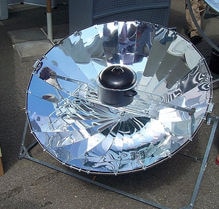
Solar Dish Collector
Solar Dish Shaped Concentrator
![]() Another type of concentrating solar collector that optically reflects and focuses the suns incident solar energy onto a small receiving area using mirrors or lenses is called a Solar Dish Collector, or more technically, a point focusing collector.
Another type of concentrating solar collector that optically reflects and focuses the suns incident solar energy onto a small receiving area using mirrors or lenses is called a Solar Dish Collector, or more technically, a point focusing collector.
By concentrating the sunlight to a single spot, the intensity of the receiving solar energy is magnified many times over with each mirror or lens acting as a single sun shining directly at the same focal point on the dish meaning that more overall power per square meter of dish is achieved.
The concentration factor, also known as the “number of suns”, of a solar dish collector can be greater than 1,000 suns reaching temperatures at the focal point of the receiver (called the “target”) approaching several hundred or even several thousand degrees Celsius depending upon the size of dish and its location.
Unlike the previous solar collector which was in the shape of a long trough, a parabolic solar dish collector is very similar in appearance to a large satellite TV or radar dish making it much smaller than a long trough collector. The curved parabolic shaped dish, which is generally referred to as a “solar concentrator” is the main solar component for this type of solar heating system.
Solar Dish Reflection
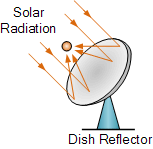
The solar dish is formed into a paraboloidal shape by stamping them out from thin sheet metal or thin aluminium coated mylar, and which themselves can be anywhere between a few feet to several metres in diameter. The parabolic dish collects the incoming solar energy directly from the sun and concentrates or focuses it on a small focal point area positioned in front of the dish.
The parabolic solar dish is covered with many small mirror reflectors all around its shape to help concentrate the thermal energy into a single focal point were the heat absorber is located producing more overall thermal energy per square meter of dish.
These highly polished mirrors can reflect more than 90% of the sunlight that hits them increasing the efficiency of the dish by more than 20% compared to the parabolic trough collector. Mirrors are generally used instead of a single highly polished dish because they are relatively inexpensive, can be easily cleaned and last a long time in an extreme outdoor environment, making them an excellent choice for the reflective surface of a solar dish collector. Also individual mirrors can be easily changed if damaged.
As well as the solar dish collector, some form of thermal receiver is required to convert the focused beam of intense solar energy into heat. The solar receiver can be as simple as a small evacuated tube or a more complex solar heat engine, such as a Stirling engine generator.
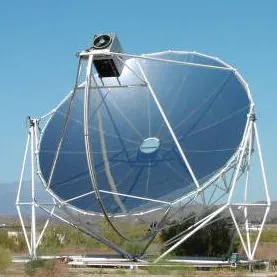
Due to the very high temperatures at the focal point, a thermal oil type fluid is generally used instead of water inside the receiver, which transfers the intense heat created by focusing the sunlight on the receiver. Like the trough collectors, solar dish collectors can be used singly or linked together for larger industrial type applications.
Solar Dish Collector type systems can also be part of another solar technology called a “solar dish-engine” system. The dish part of a solar dish engine system is very similar to the one described above, but may include many individual but smaller parabolic mirrors instead of one large single dish all angled and focused to the same focal point.
Solar Dish Collector Engine
As their name suggests, dish-engine solar collectors include a special type of solar engine built into the solar receiver. This so called heat engine, is driven by the solar thermal energy converting it into rotational mechanical output by the cyclic compression of the engine’s working gas, which is usually helium or hydrogen.
The mechanical power that is produced is then used to directly drive an electrical generator or alternator producing a significant amount of AC electrical power. These types of solar powered heat engines are commonly called a Stirling Engine after its inventor Robert Stirling in the year 1817.
Stirling engines belong to the group of closed-loop hot-gas machines that work on the basic principal that a gas will change its volume when subjected to a heat change producing an isothermal compression of the cold and isothermal expansion of the hot gas at a constant volume. This temperature change, and thus the continuous operation of the engine, is produced by moving the gas between two different chambers producing a constantly high and a constantly low temperature.
The efficiency and operation of the Stirling heat engine is determined by the operating temperature of the gas which is kept between 650oC and 750oC. To constantly keep the reflected solar radiation at the correct focal point and temperature during the whole of the day, a two-axis sun tracking system is used with the dish which continuously rotates the solar concentrator.
Like the other types of concentrating solar collector technologies, practical solar dish collectors or Stirling collectors are not suitable for domestic hot water systems due to their size, cost and very high operating temperatures. As with a parabolic trough reflector, or solar dish/Stirling systems. They are also modular in design allowing them to be connected together to form a collector field were they are connected in parallel rows ranging in size from a few kilowatts to tens of megawatts.
Solar Dish Collector As A Cooker
As well as using solar dish collectors to generate electricity at very high temperatures, the concentrating type parabolic solar dish can also be used to cook food. Something as simple as an old abandoned one metre diameter satellite dish covered in aluminium foil can be turned into a solar cooker with a black cast iron cooking pot located at its focal point. In fact a parabolic solar cooker can even be made using an umbrella and covering the inside with ordinary aluminium foil but its efficiency would be limited.
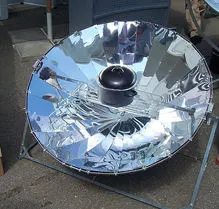
Solar cookers can be used in camping or remote areas to boil water, fry eggs, or cook cakes and breads at temperatures well above 200oC. These temperatures are hot enough to cook most foods without the danger of a fire.
Solar cookers, and ovens are relatively inexpensive and easy to make for remote cooking applications, even backpack versions are sold for camping. However, solar cookers require frequent adjustment to stay focused on the sun as well as supervision for safe operation.
A word of warning about using solar cookers, the focal point and cooking pot gets very hot so it is advisable to wear good quality sunglasses and gloves as the focused solar energy glare can create nasty burns or could damage your eyes for good. So avoid standing on the sunny side of a solar dish collector.
In the next tutorial about Solar Heating we will look at another type of solar thermal collector which is designed to concentrate the received solar radiation even more into a single focal point using an array of adjustable mirrors around its base.
This type of solar thermal collector can reach temperatures well into the thousands of degrees and is generally known as a Solar Power Tower. Solar power towers focus the sun’s energy onto a single point hot enough to melt salt.





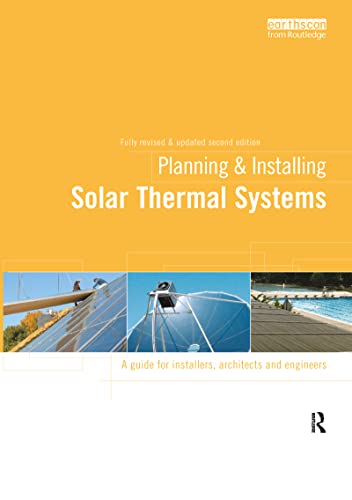




Can i use a solar dryer in the place of the solar cooker in this design. is yes, how do i maintain the temperature required for drying to avoid burning food in the dryer ?
Solar Cookers are generally large sealed and insulated boxes (Solar Box Cooker), or parabolic shaped reflectors or dishes (Solar Panel Cookers) to concentrate the suns energy onto a central focal point at the bottom, or the side of a cooking pot. Both types are designed to operate at high enough temperatures to cook food, or boil liquids.
Solar food dryers and solar clothes dryers operate on a greenhouse effect requiring air flow. An enclosure is required which surrounds the air and material inside to be heated start off at low temperatures and high humidity. Gradually, the internal temperature rises due to the greenhouse effect. Ventilation and air flow can be either natural or forced ventilation using a fan to remove the humid dense air.
Temperature regulation can be manual (opening a vent of lid), or automatic using a greenhouse vent opener set to the required temperature. Either way, air circulation is the required element of solar drying.
Can you help me build a solar array that can make 40 mega-liters of freshwater from salt water 24/7?
I need lots of physics questions answered. A 740 parabolic dish concentrates 100,000 watts of energy into 1 sq.m. 1/ How many parabolic dishes will it take to make 4 mega-liters of Super-Heated-Air per hour heated to 1,500 c or more at 11,000 Bar? (Remember GODS Tax)? 2/ What is the speed of 140 liters of S-H-A per second passing through a 8X3 mm jets making the gas spin like a cyclone? What is the difference to the speed (of 2.) if we add 1 mega-liter of saltwater per hour at 100c into a pressure vessel 28m.dia. x10m high, that is heated to 1,000c x11,000 bar? Will the salt become a liquid? What is the temp.of the liquid salt? We continue adding the S-H-A. The Liquid salt will rotate, also creating a whirlpool. If the liquid salt were to build up to 1 mega-liter, could we generate electricity using a paddle in the l/s? As the S-H-A & the steam exit the pressure vessel, how much electricity can it generate? What would the cost of each generator be, please?
What will be the best liner for the pressure vessel?
NFP Administrator: If you require more info, please email me. There is a strong possibility of a student getting a PhD when we build this project.
Thank you for your numerous questions, but basically no, we cannot help you.
Hello, do you have any reference books for this article? I badly need it for my study. Thank you
I’m glad i found my self in this kind of site because I’ll need u guys assistance on my undergraduate project. Though i got a topic on solar energy “universal solar cooker”. The solar aspect is a bit clear but I’m having a challenge on how to store the energy without cooking inside the sun and also how to incorporate the usage of electricity as an alternative power source as the topic implies. Thank you very much I’ll be expecting a response from everyone……………
Hello Ibromaka, A solar cooker is basically a reflective box for cooking food using the sun’s direct energy and as such there is no way of storing the heat energy unless you wish to use an alternative method of cooking. You can find more information here about cooking with the sun. Regarding an alternative power source for cooking food, you will need heating elements, solar panels and batteries and there a lots of articles here to help you.
I still have not been able to find a solar energy installer who uses Stirling engine technology/ Maybe it is not as developed over time as the PV panels but it seems to me the cost would be much less to install and the resulting profits to generators of electricity would be much bigger. So you know of any installer who uses the Stirling engine/parabolic collector method?
Stirling Engine designs have been around for many hundreds of years and as such is a well established technology. Using a parabolic dish to focus the suns rays onto a central receiver to produce more power out of a given amount of insolation is a simple idea, but the temperatures involved can be in the thousands of degrees and the resulting glare from the parabola for the neighbours makes them more suited to larger solar water-heating installations. However, there are manufacturers who produce smaller systems constructed from lightweight, polished, and aluminiumised plastic parabolic reflectors and troughs that track the sun to produce hot water or focus it onto PV panels to produce electricity.
Can you name any of these manufacturers/installers so I can contact them? I have not been able to find on the internet.
Hello Tom, I am not aware of any Stirling Engine Suppliers, sorry. 🙁